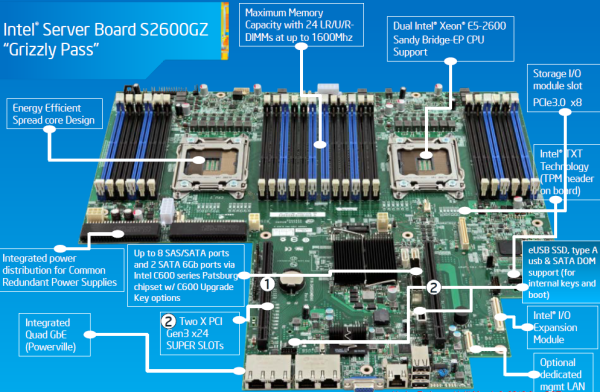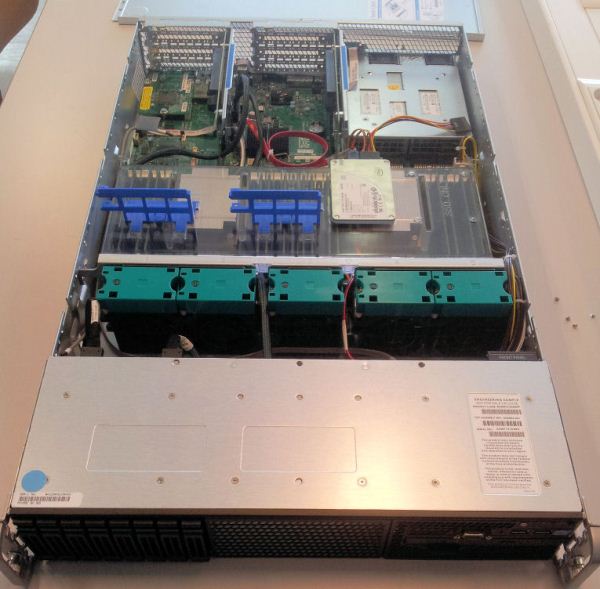The Xeon E5-2600: Dual Sandy Bridge for Servers
by Johan De Gelas on March 6, 2012 9:27 AM EST- Posted in
- IT Computing
- Virtualization
- Xeon
- Opteron
- Cloud Computing
The Intel S2600GZ board
Our Intel R2208GZ4GSSPP had the Intel S2600GZ "Grizzly Pass" board inside. The board has been qualified for all major virtualization solutions: Citrix Xenserver, Hyper-V, SLES 11, Oracle's VM server, RHEL and VMware vSphere of course. It can also be used as basis for almost every independent storage software vendor: DataCore, Falconstore, Gluster, Microsoft's iSCSI target, Nexenta, Open-E and Stormagic.
The board has a cooling and power-friendly spread core design: the airflow of one heatsink does not get used to cool another heatsink. The board features up to 24 DIMMs, which support Low Power, Unregistered and Registered DDR3 (up to 1600 MHz) and LR-DIMMs. Four GBe interfaces are on board and an optional I/O module can add dual 10 GBe (Base-T or optical) or QDR infiniband. Meanwhile the C600 chipset offers 8 SAS/SATA ports (2x 6G) and a PCIe 3.0 x8 module slot for stroage purposes. This slot can be used for setups such as the LSI 2208 dual core ROC controller based RAID card with two 8087 SAS connectors and 1 GB of 1033 MHz DDR3 cache.
Last but not least: the board has two PCIe x24 "super slots" which allows for the use of two risers. Each riser contains 3 PCIe 3.0 x8 slots: two half height slots and a full height slot. Finally, powering the system is a small 750 Watt PSU rated for 80 PLUS Platinum.












81 Comments
View All Comments
JohanAnandtech - Wednesday, March 7, 2012 - link
Argh. You are absolutely right. I reversed all divisions. I am fixing this as we type. Luckily this does not alter the conclusion: LS-DYNA does not scale with clockspeed very well.alpha754293 - Wednesday, March 7, 2012 - link
I think that I might have an answer for you as to why it might not scale well with clock speed.When you start a multiprocessor LS-DYNA run, it goes through a stage where it decomposes the problem (through a process called recursive coordinate bisection (RCB)).
This decomposition phase is done every time you start the run, and it only runs on a single processor/core. So, suppose that you have a dual-socket server where the processors say...are hitting 4 GHz. That can potentially be faster than say if you had a four-socket server, but each of the processors are only 2.4 GHz.
In the first case, you have a small number of really fast cores (and so it will decompose the domain very quickly), whereas in the latter, you have a large number of much slower cores, so the decomposition will happen slowly, but it MIGHT be able to solve the rest of it slightly faster (to make up for the difference) just because you're throwing more hardware at it.
Here's where you can do a little more experimenting if you like.
Using the pfile (command line option/flag 'p=file'), not only can you control the decomposition method, but you can also tell it to write the decomposition to a file.
So had you had more time, what I would have probably done is written out the decompositions for all of the various permutations you're going to be running. (n-cores, m-number of files.)
When you start the run, instead of it having to decompose the problem over and over again each time it starts, you just use the decomposition that it's already done (once) and then that way, you would only be testing PURELY the solving part of the run, rather than from beginning to end. (That isn't to say that the results you've got is bad - it's good data), but that should help to take more variables out of the equation when it comes to why it doesn't scale well with clock speed. (It should).
IntelUser2000 - Tuesday, March 6, 2012 - link
Please refrain from creating flamebait in your posts. Your post is almost like spam, almost no useful information is there. If you are going to love one side, don't hate the other.Alexko - Tuesday, March 6, 2012 - link
It's not "like spam", it's just plain spam at this point. A little ban + mass delete combo seems to be in order, just to cleanup this thread—and probably others.ultimav - Wednesday, March 7, 2012 - link
My troll meter is reading off the charts with this guy. Reading between the lines, he's actually a hardcore AMD fan trying to come across as the Intel version of Sharikou to paint Intel fans in a bad light. Pretty obvious actually.JohanAnandtech - Wednesday, March 7, 2012 - link
We had to mass delete his posts as they indeed did not contain any useful info and were full of insults. The signal to noise ratio has been good the last years, so we must keep it that way.Inteluser2000, Alexko, Ultimav, tipoo: thx for helping to keep the tone civil here. Appreciate it.
- Johan.
tipoo - Wednesday, March 7, 2012 - link
And thank you for removing that stuff.tipoo - Tuesday, March 6, 2012 - link
We get it. Don't spam the whole place with the same post.tipoo - Tuesday, March 6, 2012 - link
No, he's just a rational persons. I don't care which company you like, if you say the same thing 10 times in one article someones sure to get annoyed and with justification.MySchizoBuddy - Tuesday, March 6, 2012 - link
I'm again requesting that when you do the benchmarks please do a Performance per watt metric along with stress testing by running folding@home for straight 48hours.